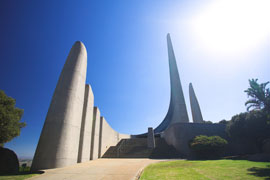| |
|
SOUTH AFRICAN CULTURE
Welcome to our guide to South Africa. This is useful for anyone researching South African culture, customs, manners, etiquette, values and wanting to understand the people better. You may be going to South Africaon business, for a visit or even hosting South African colleagues or clients in your own country. Remember this is only a very basic level introduction and is not meant to stereotype all South Africans you may meet!

| |
|
|
|
| |
South African Languages and Culture
South Africa is the Rainbow Nation, a title that captures the country's cultural and ethnic diversity. The population of South Africa is one of the most complex and diverse in the world. Of the 51.7 million South Africans, over 41 million are black, 4.5 million are white, 4.6 million are coloured and about 1.3 million Indian or Asian. About 51.3% are female, and 48.7% male.
The black population of South Africa is divided into four major ethnic groups; namely Nguni (Zulu, Xhosa, Ndebele and Swazi), Sotho, Shangaan-Tsonga and Venda. There are numerous subgroups within these, of which the Zulu and Xhosa (two subgroups of the Nguni group) are the largest.
The majority of the white population (about 60%) is of Afrikaans descent, with many of the remaining 40% being of British or European descent. The coloured population have a mixed lineage, which often comprises the indigenous Khoisan genes combined with African slaves that were brought here from all over the continent, and white settlers.
Most of the coloured population lives in the Northern and Western Cape provinces, whilst the majority of the Indian population lives in KwaZulu-Natal. The Afrikaner population is especially concentrated in the Gauteng and Free State provinces and the English population in the Western Cape, Eastern Cape and KwaZulu-Natal.
There are eleven official languages in South Africa. These are English (9.6%), Afrikaans (13.5%), Ndebele (2.1%), Sepedi (9.1%), Xhosa (16%), Venda (2.4%), Tswana (8%), Southern Sotho (7.6%), Zulu 22.7%), Swazi or SiSwati (2.5%) and Tsonga (4.5%). Much of the country’s media has been tailored to include as many of these languages as possible. Of course, many other languages from all over the world are spoken here too; including Portuguese, Greek, Italian, French, Chinese, and so on.
View more information about each (see below), including the origins of the language and where it is spoken in South Africa. Also see South Africanisms and useful Xhosa phrases and Zulu phrases.
|
|
| |
|
| |
|
|
|
| |
|
|
|
| |
Afrikaans Language

Afrikaans Language Monument outside Paarl
The Afrikaans language is one of South Africa’s official languages and a large proportion of the local population uses it as their first or second language. It is still taught in schools.
Afrikaans has a fascinating history of its own, and a heritage and culture that are deeply entwined in its character.
The language is also widely spoken in Namibia and, to a lesser degree, in Zimbabwe, Botswana and other surrounding countries. Some believe that Afrikaans is a dying language, however, it remains spoken all over the country and respected for its origins.
“Afrikaans” is a Dutch word that means “African”. Afrikaans was formed as a language in Cape Town, thanks mainly to the French and Dutch settlers of centuries ago. Today, the Mother City is still home to a smorgasbord of nationalities. Historically, the main nationalities that contributed to South African society were Indonesians, Madagascans, Khoi, the Dutch settlers and West Africans.
Afrikaans is heavily based on the Dutch language. Today, the original dialect is still referred to as Kitchen Dutch, Cape Dutch or African Dutch. It was only in the late 19th century that Afrikaans was actually recognised as a separate language to Dutch. In 1961, Afrikaans became one of the official languages of the country, along with English.

South African School Children
The dialect in the north-east was a form of Afrikaans and the written standard was developed from this. Afrikaans is spoken as a first language by 60% of white South Africans and by about 90% of the local coloured folk. Many South African races use Afrikaans as their second or third language.
Afrikaans has been labelled by critics as being an "ugly language" for its guttural quality. This has not prevented it from gaining popularity in many other countries, though. Universities in Belgium, the Netherlands, Germany, Austria, Russia and Poland are also teaching Afrikaans.
In 1975, Afrikaans-Language Monument (photo above) was built near the town of Paarl in the Western Cape Province. The structure was extremely impressive and was created to commemorate and honour the Afrikaans language.
Afrikaans has made its mark on local culture and the South African identity. |
|
| |
|
| |
|
|
|
|
|
|
|


































